Monthly Diary 2024
Monthly Diary 2024
December 2024
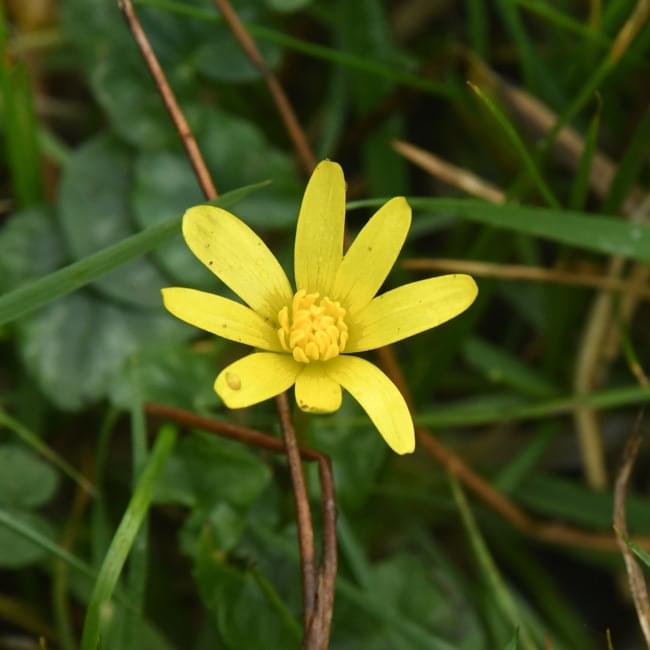
Now this is rather an unusual Christmas flower and it was not really what I was expecting to see whilst wondering around the Green on Christmas Eve! It is lesser celandine, whose bright yellow flowers are normally a welcome sight in late February and herald that Spring is on its way. It just goes to show that the mild weather we are experiencing is definitely having an effect on our wildlife.
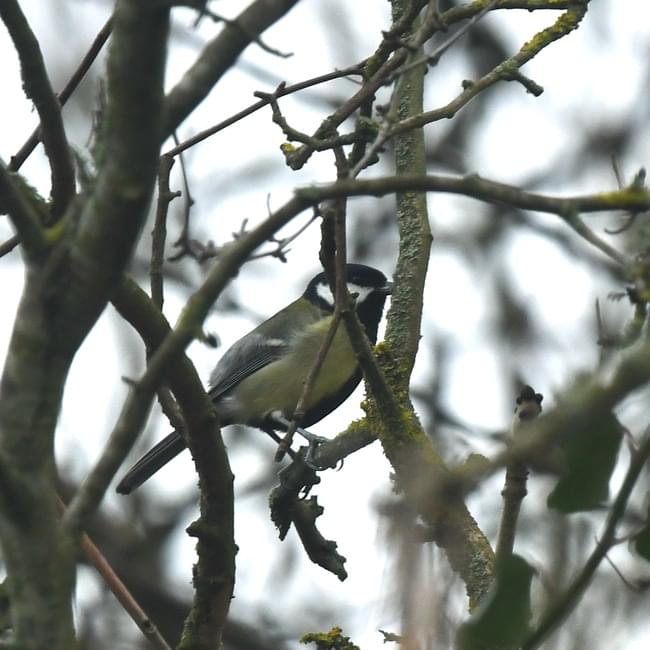
The birds also seem to be responding to the warmer weather and are becoming more vocal. Whilst the thrushes are starting to sing, it was these great tits that were making the most noise. They were chattering in the ash tree by the brook and were being very uncooperative about having their photo taken — they wouldn't sit still and when they did, they were amongst all the branches and usually facing the wrong way! So whilst this isn't a great photo, it still makes me smile.
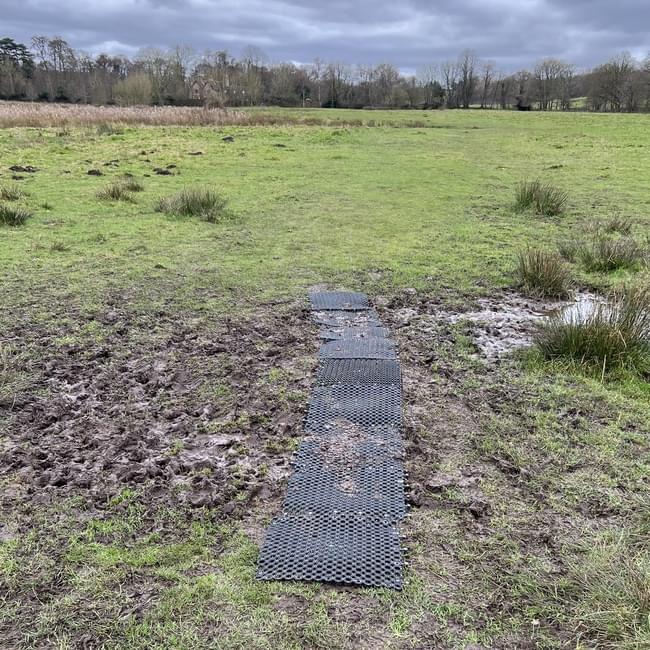
With all the rain we have had over the last couple of months, some parts of the Green have become quite muddy and so we have put some protective mats down on one section of the footpath that is becoming difficult to walk on. Hopefully they will help you negotiate this area, keep your boots a bit cleaner and help you not slide around so much! Whilst it is always tempting to walk around the muddy areas, this does cause quite a bit of damage to the meadow and is something we are asking people to avoid doing. So please, make use of the mats and please try to keep to the main footpaths, as well. Thank you.
So it just remains for me to say have a lovely festive break and enjoy your visit to the Green. We look forward to having your continued support in 2025 and yes, we will be having more work parties next year!
November 2024
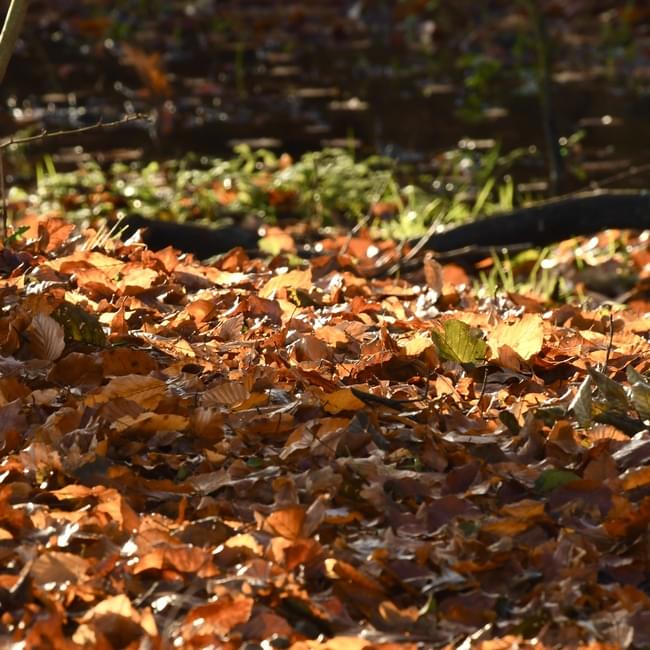
Thanks to Storm Bert, most of the leaves that were left on the trees are now lying on the ground, ready to rot down and provide nutrients for next year. The beech leaves in particular make a lovely brown carpet, which really takes on a golden glow, when lit by the sun. Oak trees, however, hold onto their leaves for a bit longer and if you look around the Green, you will see that the only trees with any leaves left on them are the oaks!
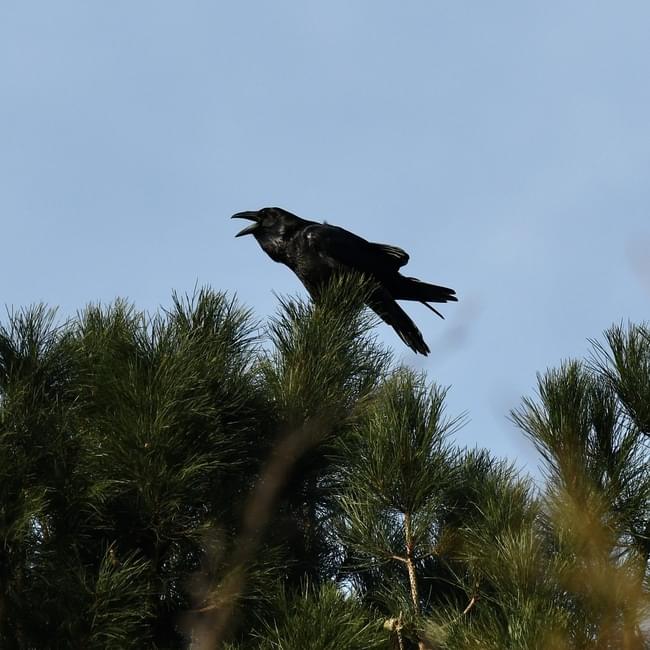
Over the last few weeks, we have been lucky enough to have had a raven visiting the Green, which is very exciting. They are huge birds - bigger than a buzzard and make a very distinctive kronking noise. In fact I usually hear them, before I see them! This one, is favouring the mature pine trees on the Maple Hayes side of the Green, where it sits and makes quite a noise! Ravens are normally found in the north and west of the UK (unless you happen to visit the Tower of London!), but their numbers are increasing and their ranges are expanding. So, you never know, this majestic bird may be thinking about taking up residence on the Green!
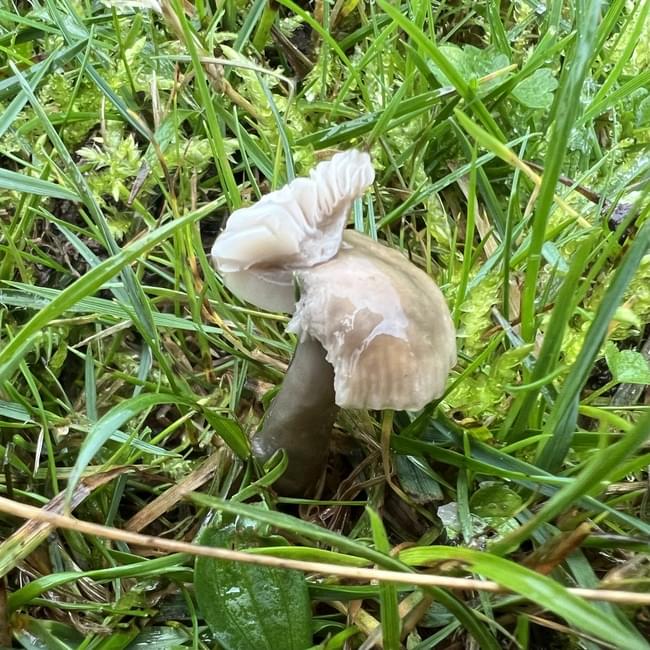
Earlier on in the month we were very lucky to have the incredibly knowledgable Beverley Rhodes visit us and undertake a fungi survey of the Green. Whilst I know that the Green supports a good selection of important fungi, I didn't quite appreciate how many different species we have, particularly of the lovely waxcaps. The one that really caught my interest, was the aptly named slimy waxcap (Gliophorous irrigata). Whilst it's not as colourful as some of the others, I just think the gloopy surface of the cap is amazing! For those that are interested, the proper term for gloopy, is viscid, but either way, it does look like it's got a bad cold!
October 2024
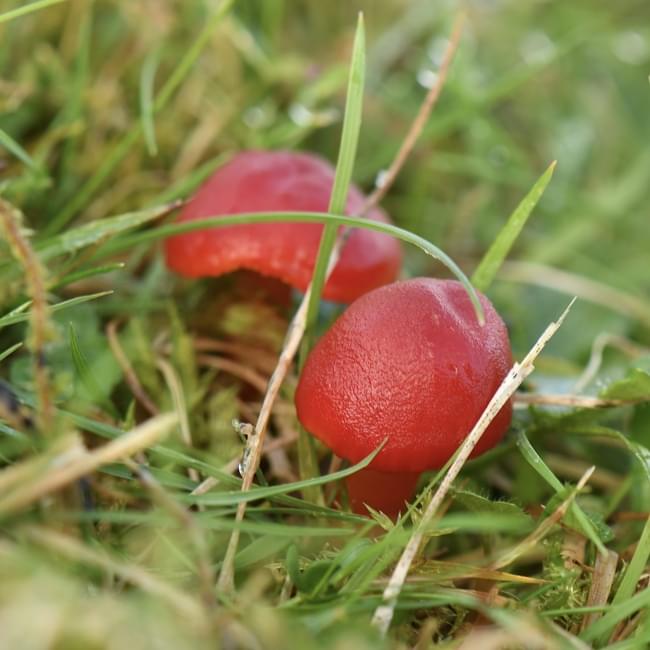
An October post would not be the same without mentioning the lovely waxcap fungi that we have growing on the Green. This year they are putting on a wonderful display, both in variety and numbers. They come in a range of colours including red, yellow, green and white and they look like little jewels nestling in amongst the grass. Due to their small size, they can be quite difficult to see, but once you've seen one, you will start seeing a whole lot more! Unfortunately, there is a decline in waxcaps across the UK, so we need to do as much as we can to protect what we have on the Green. More about waxcaps can be found on our fungi page
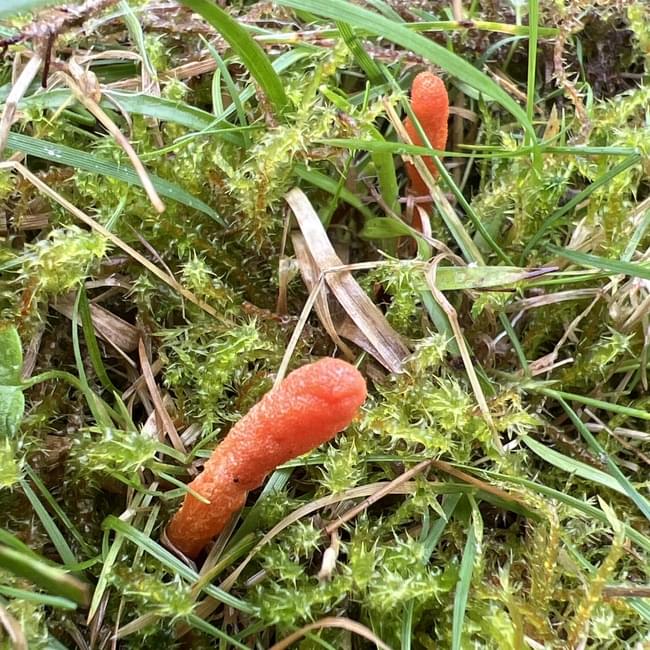
So what is this weird looking orange thing poking a few centimetres above the grass? You may (not) be surprised to know that I was over the moon to find this, having read about them, but never seen one before. It is a rather strange fungus called the scarlet caterpillar club. Apart from having a bright orange club-shaped fruiting body, what makes this fungus even more amazing is that it is parasitic and grows on the caterpillars of moths and butterflies (hence its name!). Incredibly, fungal spores can land on a caterpillar and as it buries itself in the ground to pupate, the fungus starts growing from inside the caterpillar. Needless to say, the caterpillar is transformed into a mushy mess!
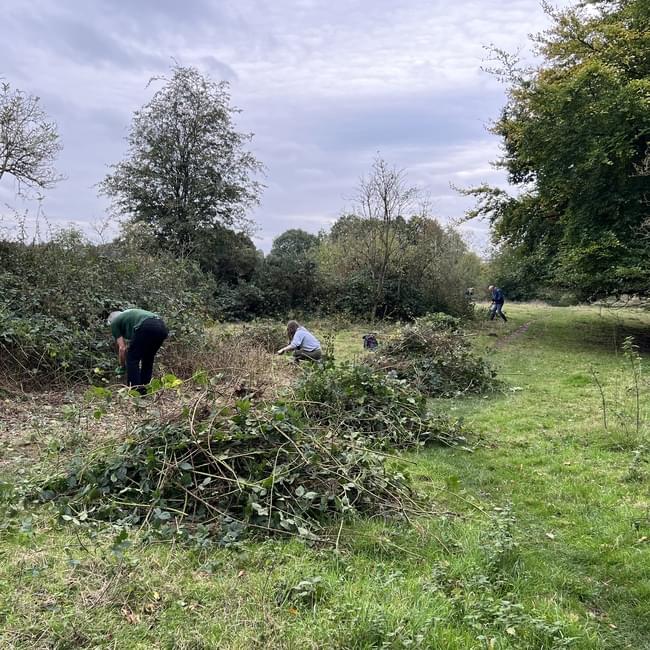
We had our last work party of the year earlier on the month and focused on clearing some of the bramble from the meadow area. Having some bramble is a good thing as it provides nectar for insects, nesting sites for birds and protection for small mammals etc, but unfortunately it does spread rather rapidly. Consequently we need to control it and it was great to have a good turn out of volunteers to come and help us cut back and contain some of the bushes. A huge thanks to everyone who gave some of their time this year to help us on our work parties - we are incredibly grateful and you most certainly made a difference. Maybe next year we can even get more people to come and help us!
September 2024
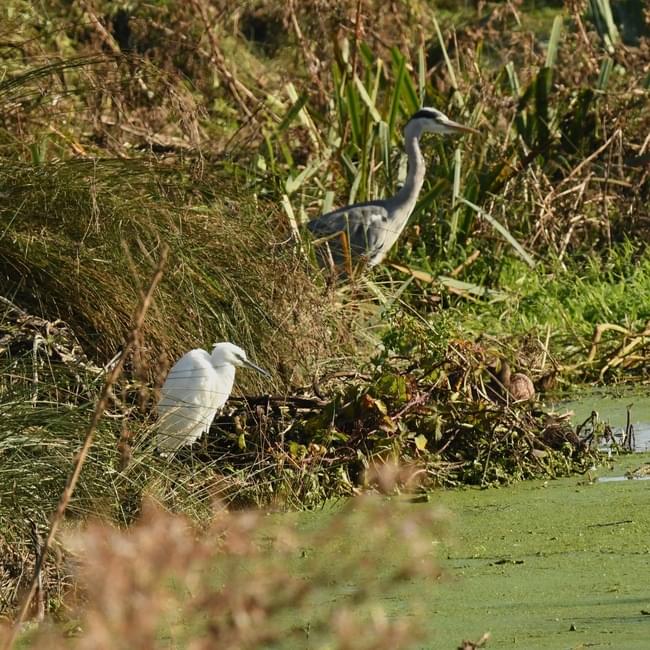
After all the rain, it was great to have a bit of sunshine the other morning and it was made even better by seeing this little egret sunning itself by the brook. They haven't been around over the summer, so it's great to see one and hopefully it will stay over the winter. What made this scene even more special was the grey heron behind the egret, and then there was another heron on the opposite side of the bank as well. Obviously it's a good fishing spot!
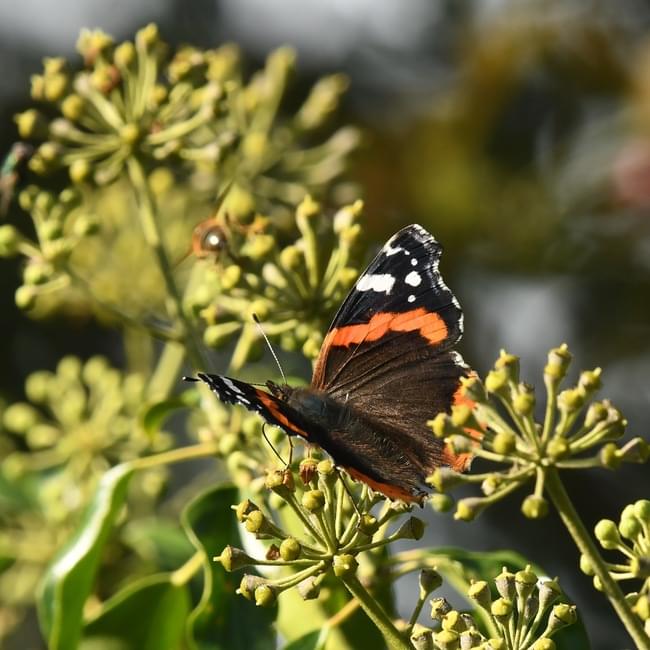
Have you walked passed any ivy recently and heard a lot of buzzing, and smelt a very sweet smell? Well, this is because the ivy is now flowering and many insects will be making the most of the sweet nectar that it's flowers produce. Ivy flowers are a really important food source for insects in September, when many plants have already finished flowering. Not only can you see bees (including the lovely ivy bee), wasps, loads of different hoverflies, but also late flying butterflies. So it was lovely to see this beautiful red admiral butterfly feeding on the ivy nectar and then basking in the Autumn sunshine.
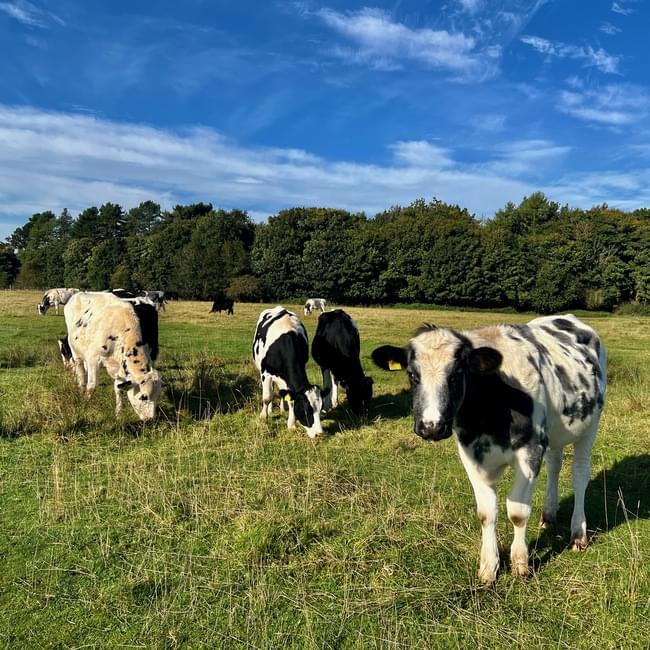
It's that time of year again, when we say goodbye to the cattle. I always get a bit sad when they go, as they are such a feature over the summer months. As usual, they have done a fantastic job in grazing and keeping the grass short, which in turn will allow the wild flowers to proliferate. A huge thanks to the farmer for letting them graze the meadow and for looking after them whilst they enjoy their summer roaming about on the Green.
August 2024
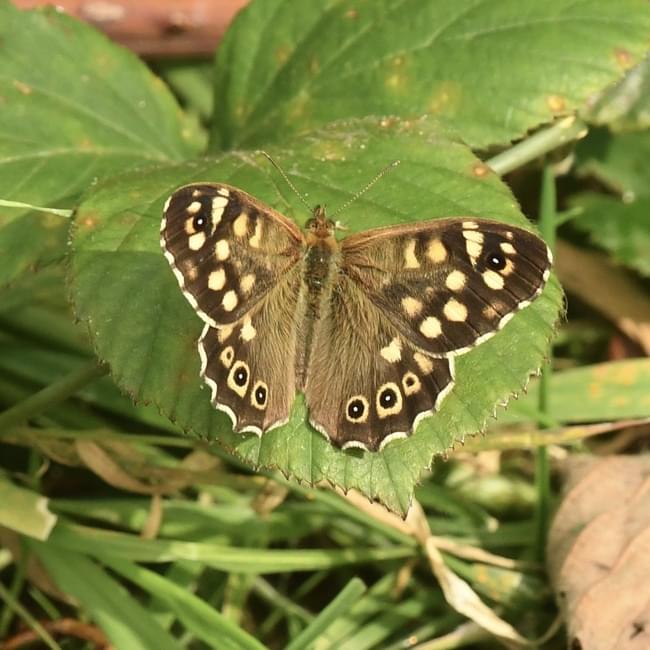
How about this for a gorgeous, newly hatched speckled wood butterfly? Just look at those beautiful creamy spots on a chocolate coloured wing! I also love the sharp white edges to the wing, which become less obvious and more tatty as the butterfly ages. Whilst I often associate these butterflies with shadier woodland rides (you will see them regularly in Leomansley Woods), they are often seen on the Green, especially along the hedgerows. So do keep an eye out for these chocolate coloured beauties.
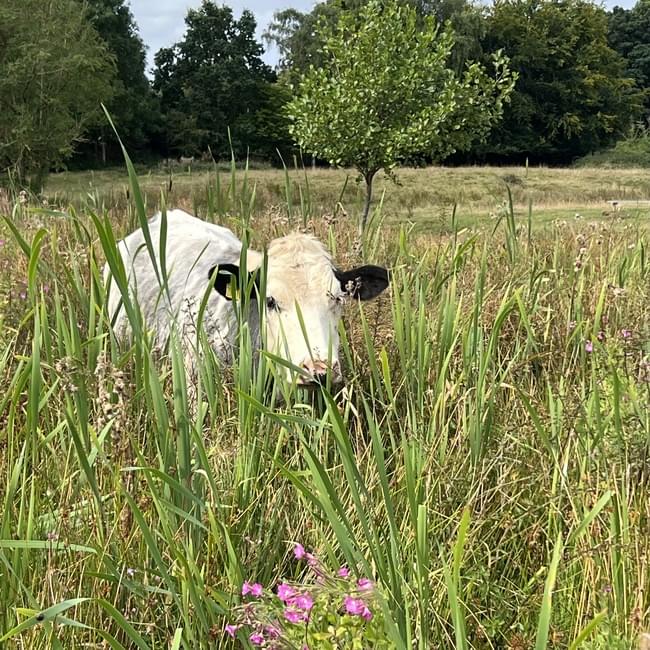
Guess who was supervising us on a recent work party? Interestingly the cattle were seeking out and eating the white root of the bulrushes that grow on the (very) wet part of the Green. This is something I have never seen before, but it turns out that bulrush roots are edible and you can even make flour from them. Just goes to show, the cattle know more than I do!
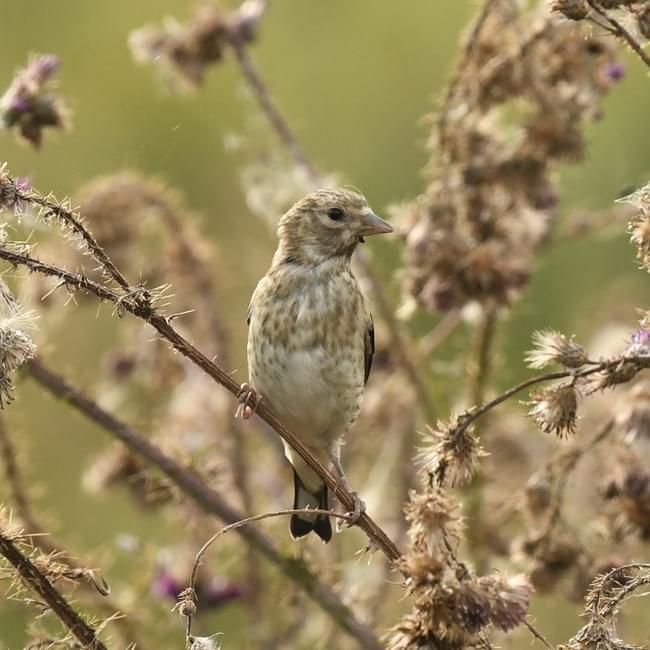
Whilst wandering on the Green the other day, I spotted this brownish bird with a streaky chest, sitting on some thistle. What is it, I thought....I don't quite recognise it. It then dawned on me that it was a juvenile goldfinch. Now the adults are easily identified by having a bright red face but this is something that the juvenile lacks, which makes identification a bit more trickier! So, if you want to challenge your bird identification skills, then try looking at some juvenile birds!
July 2024
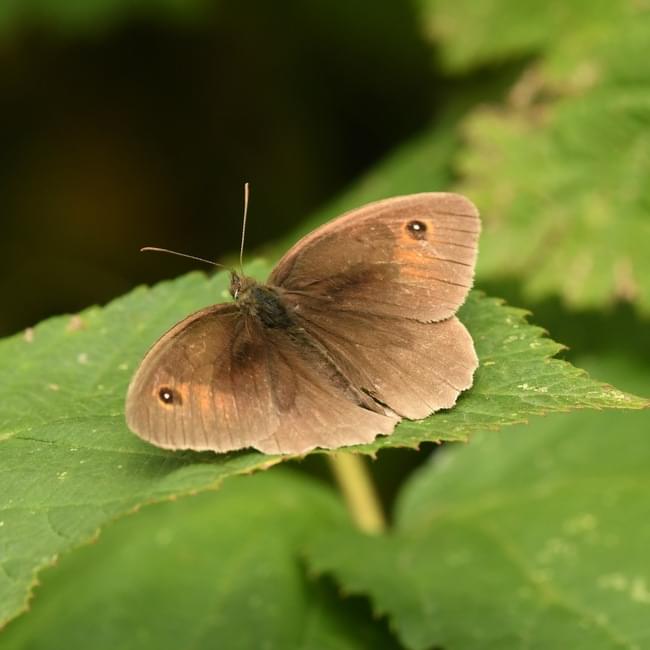
Given that July/August is “butterfly season” I thought it would be helpful to highlight some of the more common butterfly species that you can now find on the Green. First up is the meadow brown (see photo), which, as the name suggests is brown (with a bit of orange) and can be found in a meadow! You will often see it flitting amongst the grasses, especially on the Abnall's Lane end of the Green. This is one of our commonest species, and one of it's key features is a distinctive black eyespot on the forewing, containing a single white dot. Now most people don't associate grasses with butterflies, but for the meadow brown, grass is really important as the female lays her eggs on it and the caterpillar feeds on it — especially the type of meadow grasses that we have on the Green. So, this is another reason why we have to look after our meadow!
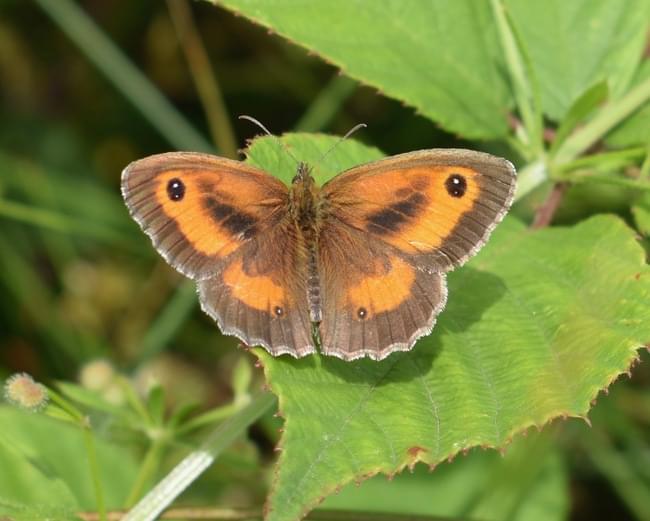
The lovely gatekeeper is another butterfly often seen on the Green, but it can be confused with a meadow brown, especially when in flight. There are some differences however — it is smaller than a meadow brown and has more orange on the fore and hind wings. It prefers a more scrubby habitat and is often seen along the boundary edges of the Green, especially on bramble. Like the meadow brown, it has a black eyespot, but the eyespot on the gatekeeper has two white dots in it … so if the butterfly stays still for long enough you should be able to work out which one it is!
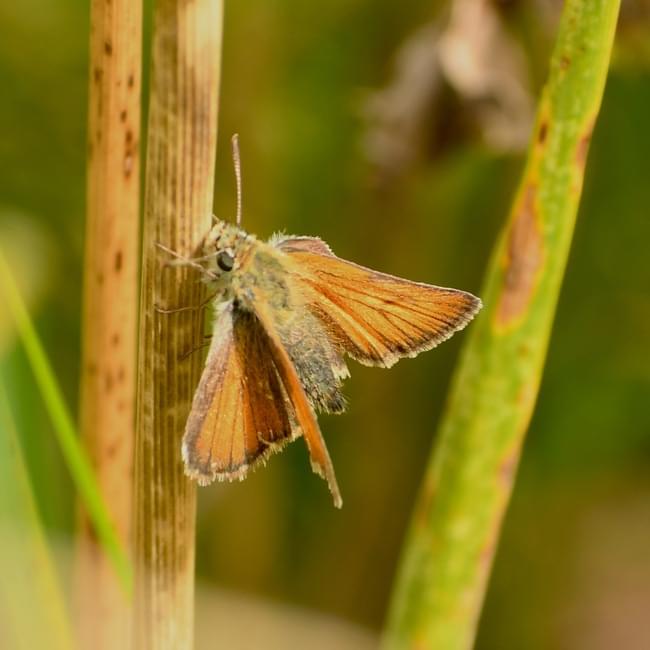
A third butterfly is another grassland species, the small skipper. This is a much smaller butterfly than the other two and at a first glance looks a bit more like a moth. It has bright orange/brown wings, which can be easily seen when it flies and you will often see it darting amongst the grasses. It's favourite grass is Yorkshire fog (of which we have quite a lot) on which the female lays her eggs and the caterpillar will feed on. Now, I don't want to confuse you, but there is also a very similar looking Essex skipper as well as a more distinguishable large skipper … but I'll leave those for another day!.
June 2024
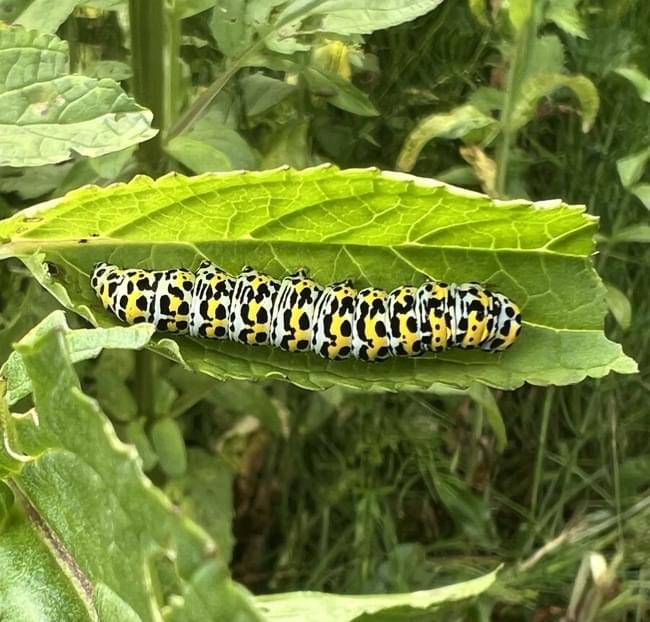
What do you think about this beauty? This rather spectacular beast is the caterpillar stage of the mullein moth and just look at those markings! The caterpillars are supposed to feed on the great mullein plant, but this one obviously didn't read the script as it was found on water figwort! You may think that the adult moth is equally spectacular, but you would be rather disappointed, as it is rather a drab brown - although very well camouflaged.
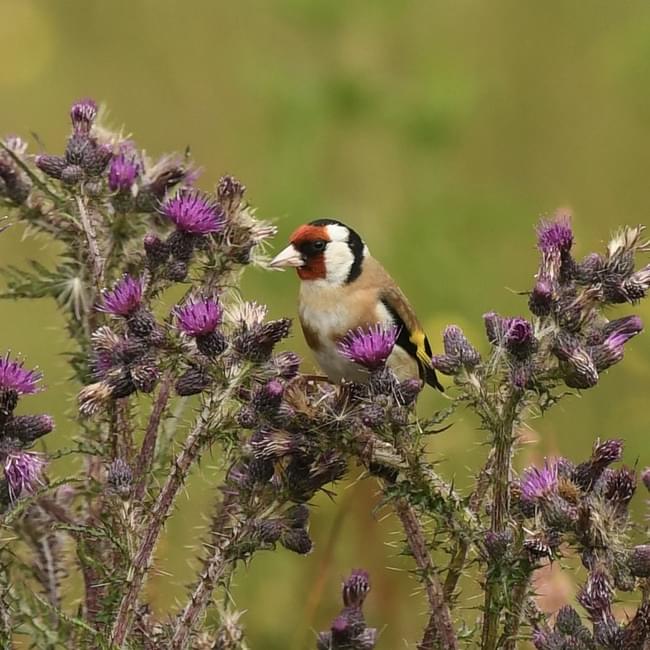
The marsh thistle are starting to flower on the wet side of the Green and they are much loved by the wildlife. The butterflies and bees readily feed on the flower nectar, whilst the colourful goldfinches adore the seeds. You can often see (and hear) a flock of goldfinches feeding on the thistle heads, so the seeds must definitely taste good!
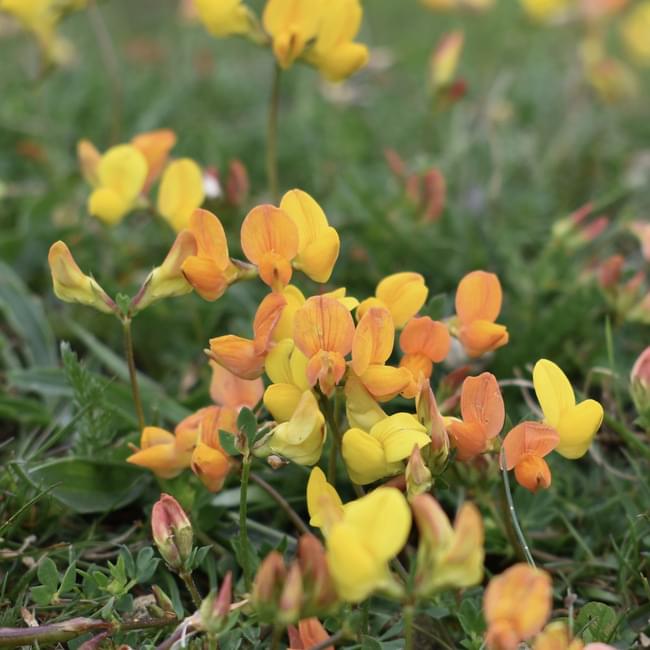
Whilst the orchids are now fading and setting their seed, there is still a wide variety of other plants that are now flowering. This includes the lovely bird's foot trefoil, which grows close to the ground and has these colourful yellowy orange flowers. It belongs to the pea family and is another very important food source for many butterflies and other invertebrates. This plant is also known as eggs and bacon, and I think from the photo, you will understand why!
May 2024
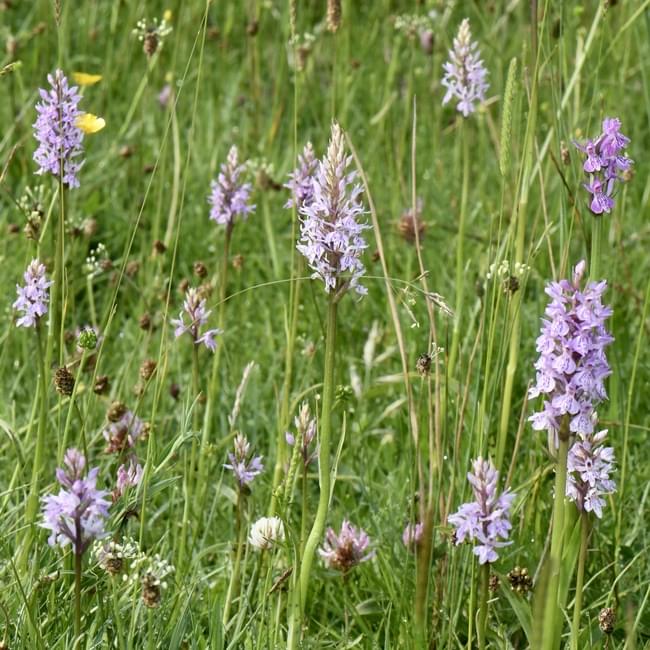
A May post would not be the same without a photo of some orchids! If you're a regular visitor to the Green, then you will know that the orchids are now flowering and are looking wonderful! If you want to find out more about the orchids (and lots of other things), then don't forget that Jane will be leading a walk, in conjunction with the Lichfield Wildlife Group, on Saturday 8th June at 10:00. Meet in the football field car park and hope to see you there!
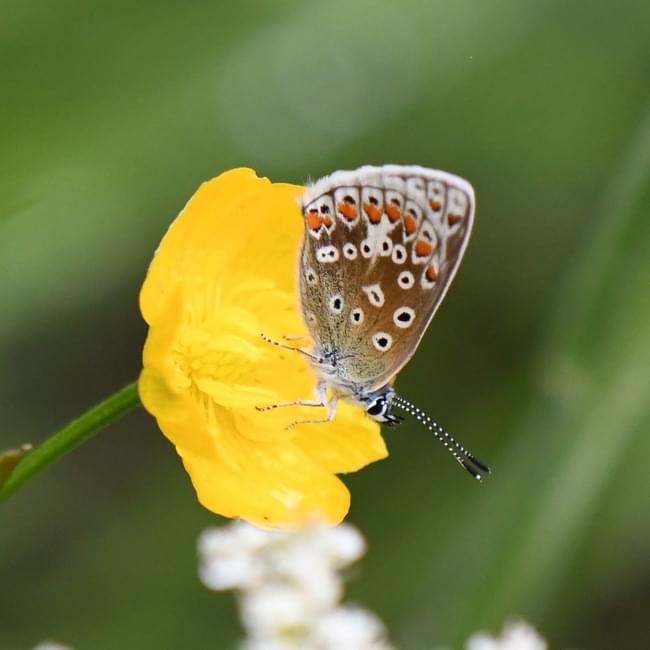
Sadly there haven't been that many butterflies on the Green this year, but butterfly numbers do seem to be down nationally, due to the wet and cold weather. However, I was delighted to see a common blue resting on a buttercup the other day. Just look at those markings on the underwing! Aren't they beautiful?
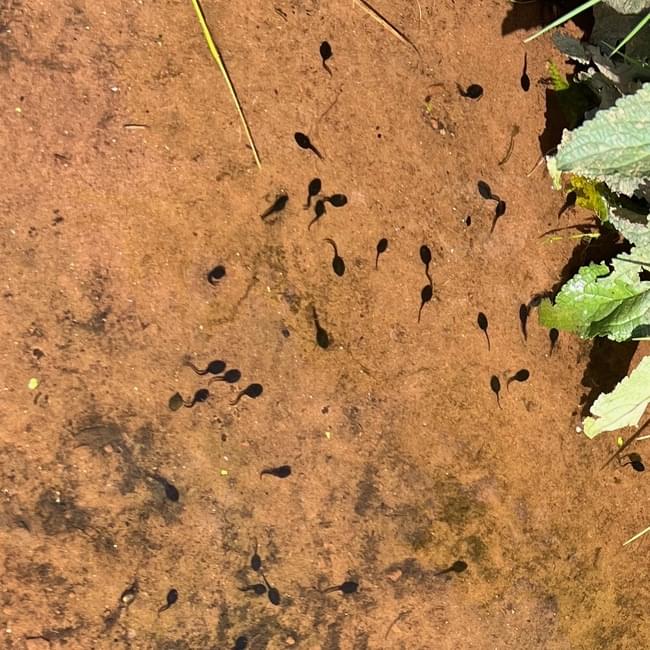
There seem to be a huge number of tadpoles in the brook this year and the other day, the area by the pipe was just covered in them! I'm not quite sure if they are from frog spawn that was laid in the brook, or whether they have been washed down from further upstream. Whatever the reason, they are a very welcome addition and the heron is already eyeing them up for when they get bigger!
April 2024
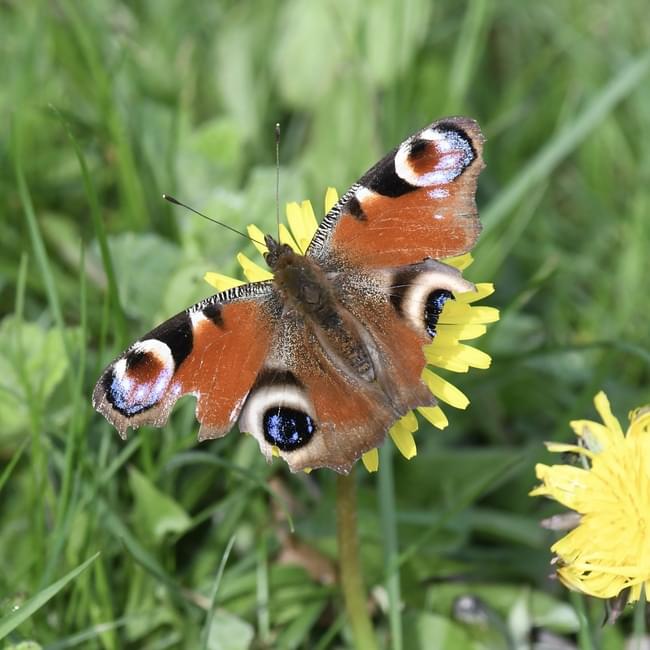
It's lovely to see more butterflies out and about, now that we are having some warmer days. Apart from the orange tip, I have also seen quite a few peacock butterfies. This one caught my eye feeeding on a dandelion and as you see it has lost some of its hind wings and is looking a bit scruffy. This is because peacocks over-winter as adults and emerge in the spring to mate and lay their eggs. This adult probably emerged last August, over wintered and is now looking for a mate. So I think you will forgive it if it looks a bit scruffy.
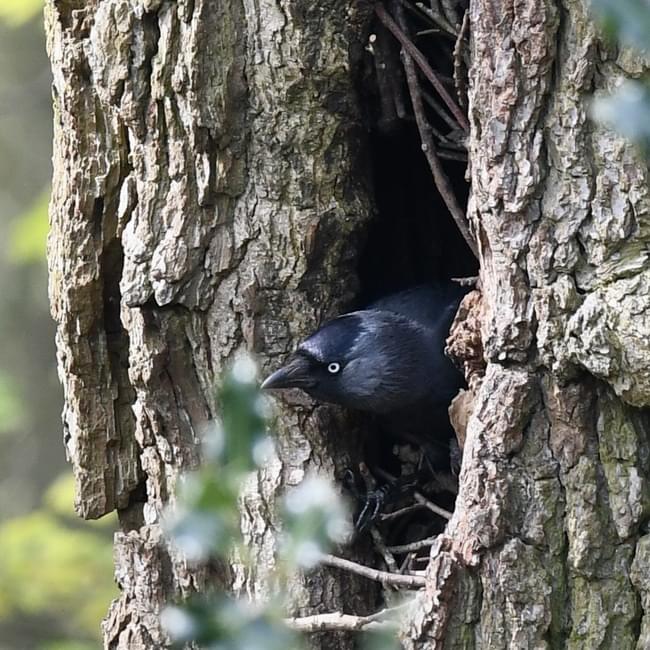
Peek-a-boo! Look whose making a nest in a crack in one of the trees on the edge of the Green! This jackdaw was very busy bringing in twigs as well as some softer nesting material. They usually pair for life and a number of them can be seen in the woods on the Maple Hayes side of the Green. Did you know that the collective noun for jackdaw is a “clattering” or a “train”?
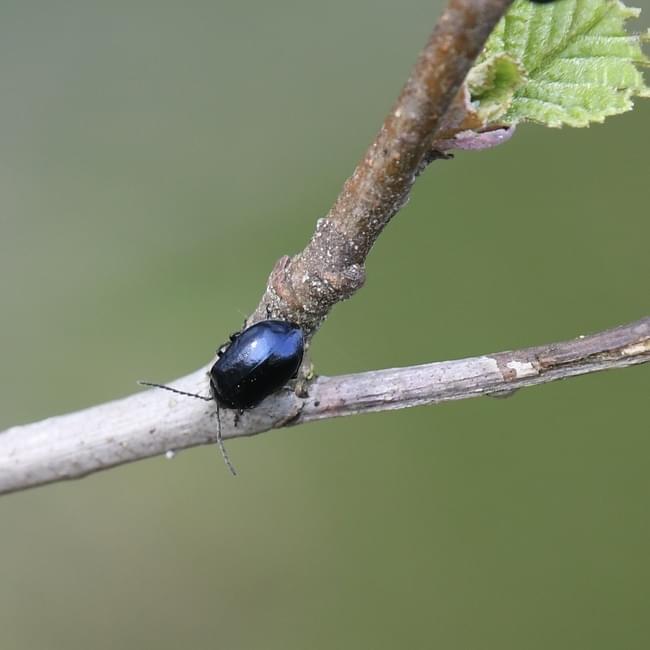
If you've been past an alder tree recently, you may have noticed lots of small black shiny beetles on the branches and leaves of the trees. Well, this is the aptly named alder leaf beetle which amazingly was considered to be extinct in the UK until its reappearance in 2004. Since then it has spread across the country and is now seen in large numbers.
March 2024
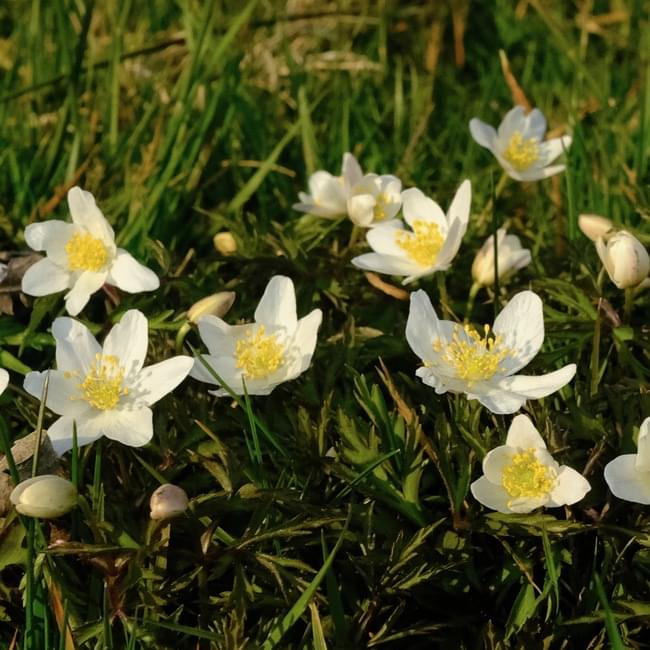
I was hoping to have seen a brimstone butterfly by now, but unfortunately, with all the cold and wet weather, that hasn't been the case! Nevertheless and definitely as good, is the wood anemone that is starting to flower. This plant is normally associated with woodland (there is an amazing display at Hopwas Woods) but we are fortunate to have a few small clumps growing on then wet side of the Green. The flowers are just beautiful and definitely one of my favourites!
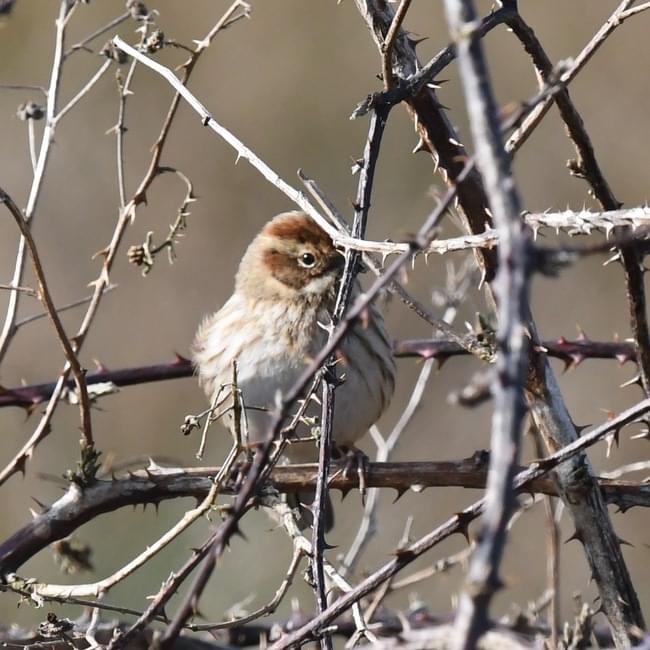
Well, last month I gave you a male reed bunting, and this month here is the female. As you can see she is not as showy as the male, having more brown plumage and in fact looks a bit like a sparrow. She was also being a little bit camera shy and wouldn't come out from behind the bramble! I spent quite a few minutes watching her being guarded by a very attentive male and fingers crossed they will have a successful breeding season.
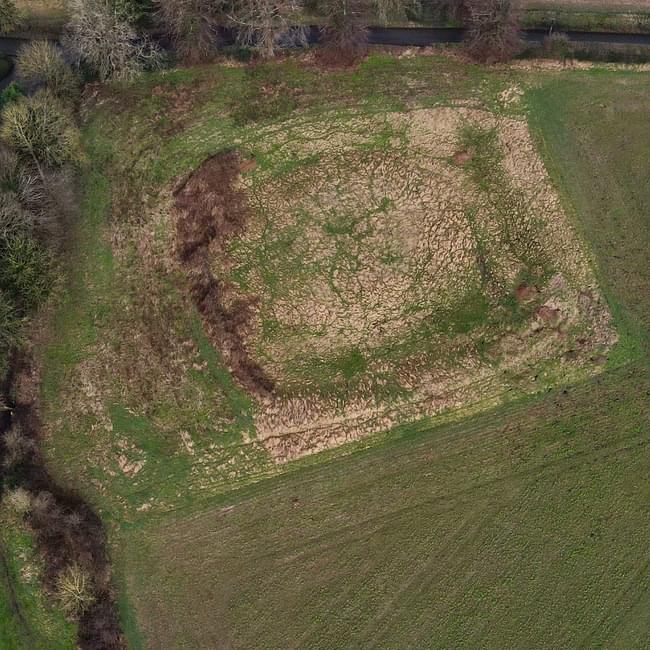
How about a bit of history for a change? Whilst taking photos of the Green with the drone last month, we also managed to get some cracking photos of the site of the moated medieval manor, which is in the field next to the Green close to Abnalls Lane. You don't really get a feel for the site from the ground, so its great to get an aerial view and be able to see the moat extending all the way around where the manor once stood. The site is a Scheduled Ancient Monument and dates to 1294, when Thomas de Abbenhall was in residence. More about the site can be found on our website.
February 2024
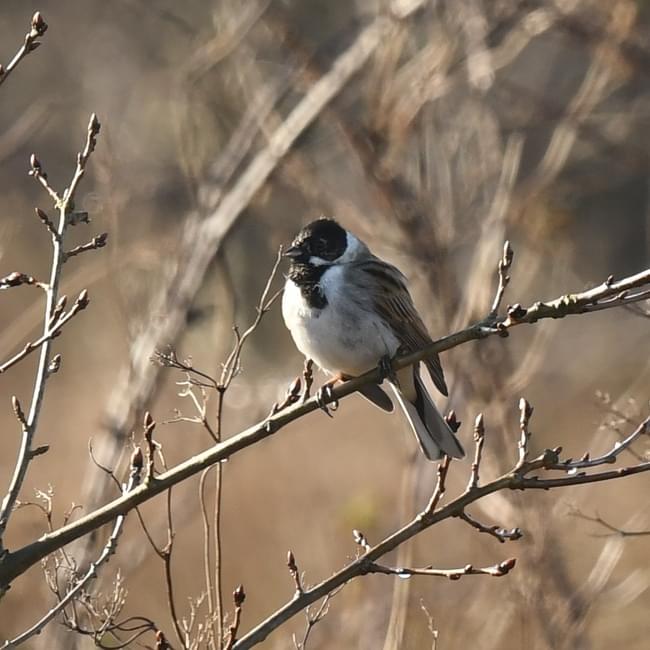
I do love reed buntings! These little birds live and breed on the wet side of the Green and in a bird survey, which we did a few weeks ago, we counted five males ... and there maybe more! This is great news as reed buntings nationally underwent a dramatic population decline in the 1980s and 1990s but fortunately their numbers have increased in recent years. They are still not out of danger though and are Amber listed (species of concern but which have not yet become critically endangered). The fact that we have such a healthy population of reed buntings on the Green highlights the importance of the wetland habitat and why we need to manage it appropriately.
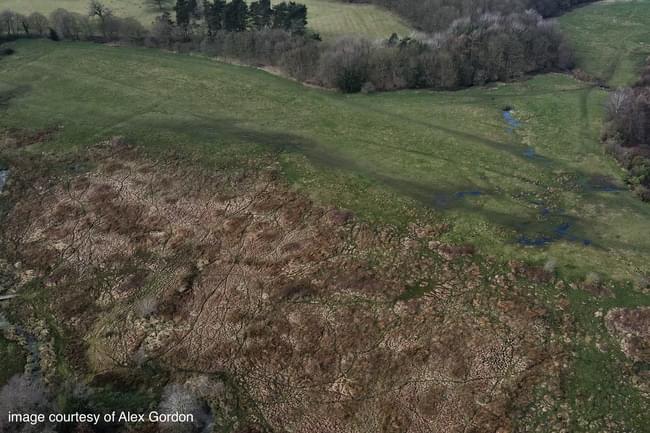
This is a rather different view of the Green and certainly gives an alternative perspective to things! A friend of the Trust kindly offered to take some drone footage a few weeks ago and I'm thrilled with the results. Not only are the images fascinating in their own right but amongst other things they give excellent detail on the different types of habitat that we have on the Green. Plus you can also see where the puddles are!
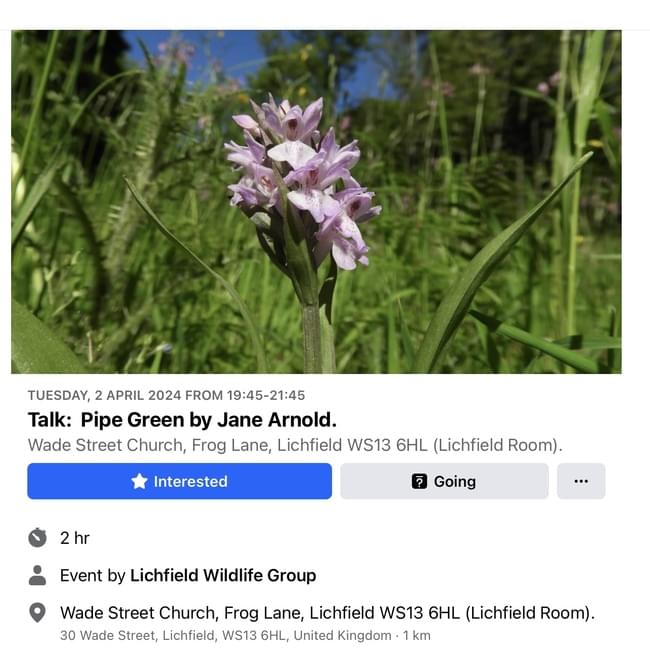
A date for the diary — come and find out more about the fascinating history, ecology and management of Pipe Green! Jane will explain how the Green has changed over the last 200 years, what amazing plants and animals can be found, how the land is managed and what challenges the Trust faces. The talk will then be followed by a guided walk of the Green on Sat 8th June, to see, amongst other things the beautiful orchids (and maybe the odd bee orchid, if we're lucky!)
January 2024
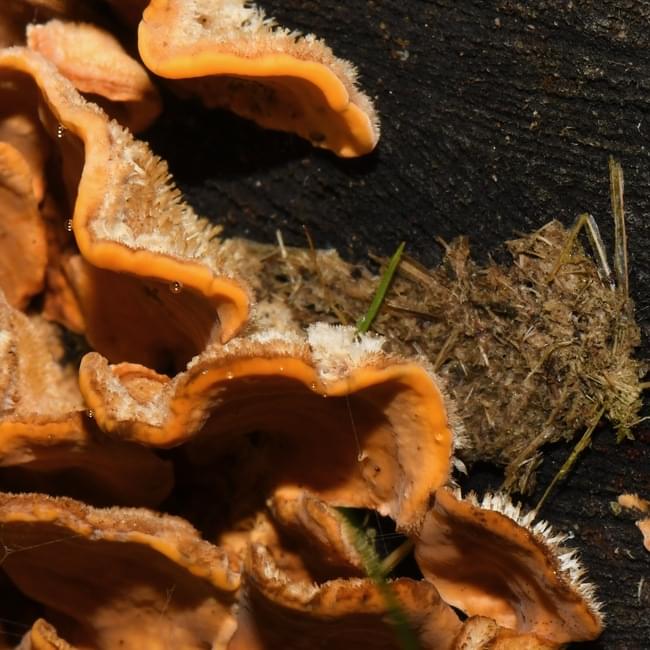
In last month's post I talked about hairy curtain crust fungi (Stereum hirsutum), and if you wondered why it is so called, then I think this close up photo will explain why. Firstly, it has a very hairy upper surface, giving it a bit of a lovely furry look — who'd have thought that some fungi have hairs! (In contrast the under surface is very smooth). Secondly, the orange brackets have a wavy appearance, which look a bit like a partially drawn curtain. Thirdly, it belongs to a group of fungi that are called "crust" fungi. If you look closely you will see that the fungi is growing directly from the wood and does not have a stem — this is a characteristic of crust fungi. So really, the name of this fungi really does describe it very well!
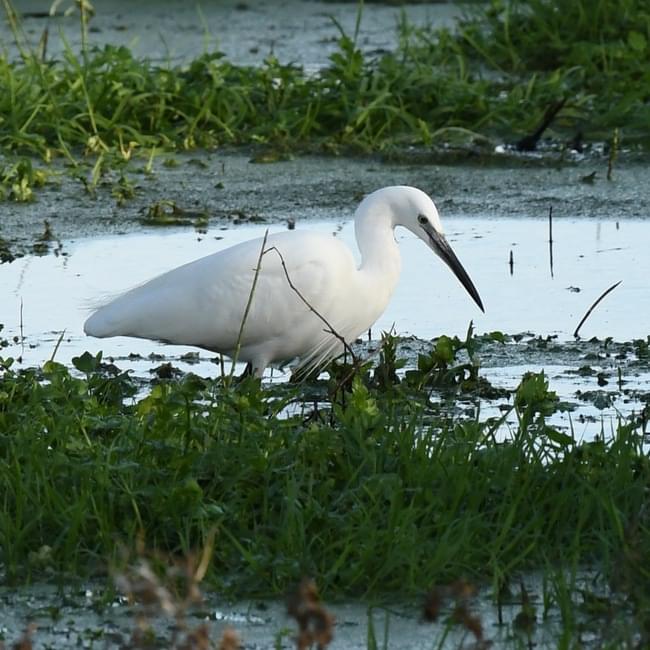
I'm delighted that the little egret has spent most of the winter on the Green and the surrounding area, including Beacon Park. The other day, it was focussed on searching for food and it was quite fascinating to watch. The egret was standing very still but then would do a puddling action with its feet, which stirs the sediment in the brook and dislodges any prey, which it then catches with its long beak. Wonderful to see!
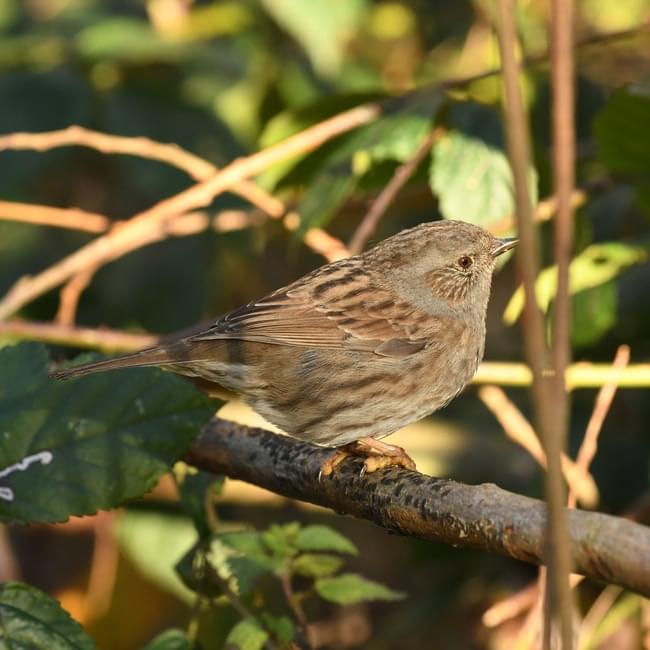
Another bird that is quite common to see along the hedgerows of the Green, is the dunnock or hedge sparrow. This little bird also frequents gardens but it is often overlooked as it has a browny grey plumage and skulks around in the undergrowth. However, when the sun comes out and lights up it's feathers, I think you will agree that the plumage is rather spectacular. I just love the markings under the eye - very handsome indeed!